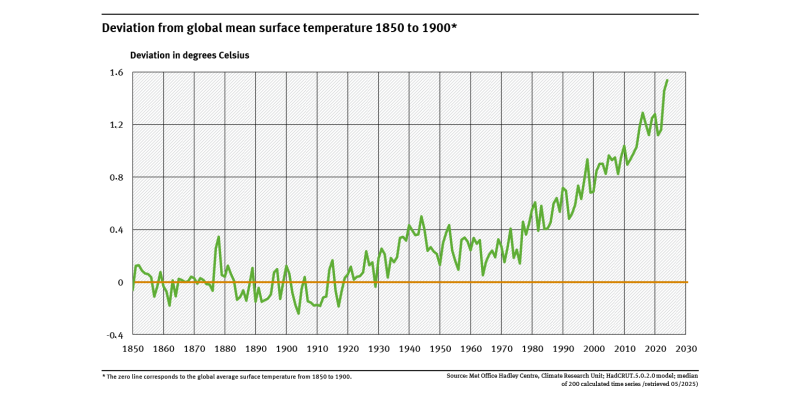Indicator: Global surface temperature
 Click to enlarge
Click to enlargeSource: Met Office Hadley Centre Figure as PDF
 Umweltbundesamt
Umweltbundesamt
 Click to enlarge
Click to enlarge
- 2024 was the warmest year worldwide since records began 1850.
- The last ten years have been the warmest years worldwide since 1850.
- The Paris Agreement stipulates that the increase in global temperature should be limited to well below 2 °C above pre-industrial levels, and even to 1.5 °C. Due to historical data availability, the comparative period used by WMO for this purpose is 1850 to 1900.
Climate change manifests itself as an increase in the global average surface temperature. But we are also seeing ocean temperature and acidity on the rise, increases in weather variability and damages and frequency of extreme weather events such as heavy precipitation, heat waves and droughts. Germany as well has growing warmer and hotter over the years, and more so than the global average. As a result, the number of hot days increases (cf. 'Hot days' indicator). The increase in average temperatures is also changing the duration of individual seasons. As of yet we have only a partial understanding of the complex effects of these seasonal shifts on plants and animals.
The global annual mean temperature alone is of little climatological significance. We obtain more information from a given year's global mean deviation from the average for a longer period in the past. This shows whether one year was warmer or cooler than the climatological average. Usually a comparison is made with the period 1850 to 1900, which is also used by the WMO.
The 'German Strategy for Adaptation to Climate Change' envisages climate impact monitoring. Climate change impacts and adaptation in different areas are published in a monitoring report which is updated every four years.
To prevent dangerous interference to the climate system, the aim is to limit the temperature increase to well below 2 degrees Celsius (°C) above pre-industrial levels, and even to 1.5 °C. This is the Paris Agreement adopted by the global community at the 2015 Climate Conference in Paris (UNFCCC 2015). To meet this target, global greenhouse gas emissions must be reduced rapidly and substantially (cf. ‘Greenhouse gas emissions’ indicator), to achieve global greenhouse gas neutrality by 2050 at the latest.
In 2024, the global mean of ground-level air temperature was about 1.54 °C above the mean from pre-industrial times, according to WMO calculations. This made 2024 the warmest and hottest year ever recorded. The last ten years were the warmest years worldwide since 1850.
The Hadley Centre's temperature data form part of an internationally recognised body of temperature datasets. As with other available datasets, the global average surface temperature is based on measurement data from meteorological stations. The global average surface temperature is calculated from worldwide measurements using a combination of calculation rules and interpolations with the HadCRUT5 model (Morice et al. 2021). In addition to the HadCRUT5 data shown here, the WMO also uses time series from other institutes, namely ECMWF, Berkeley Earth, NASA, NOAA, and JMA.
More detailed information: 'Trends der Lufttemperatur' (in German only).